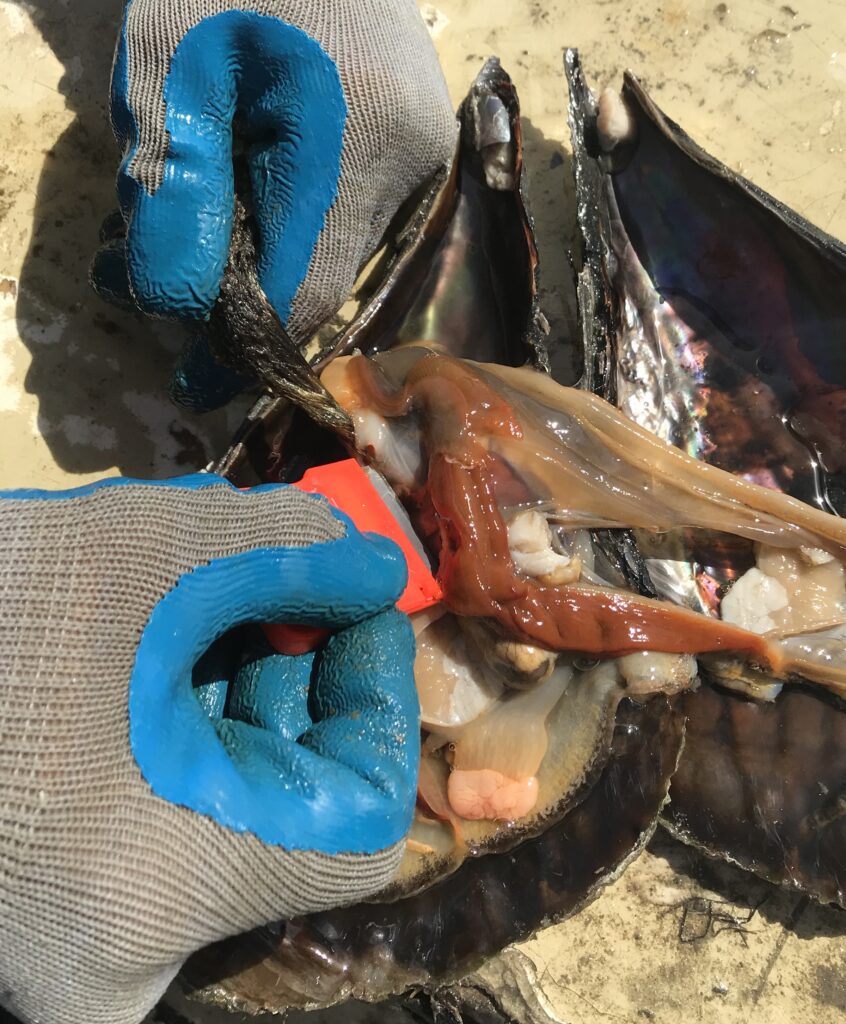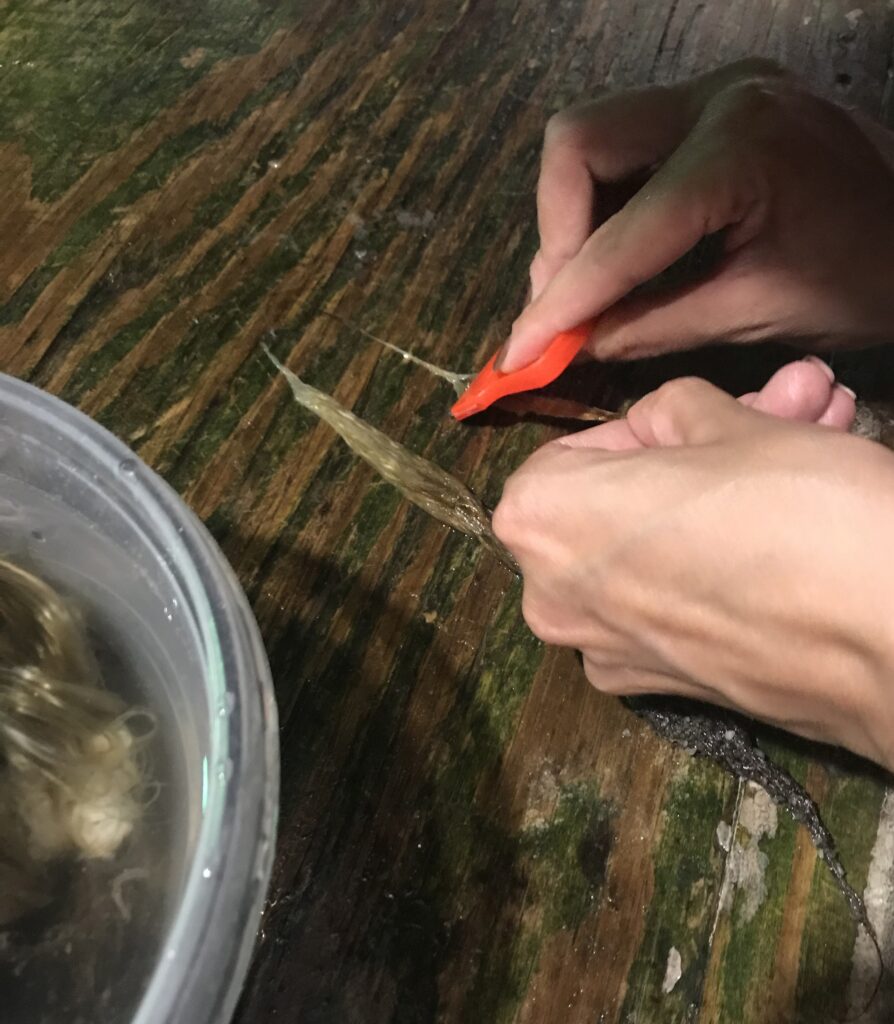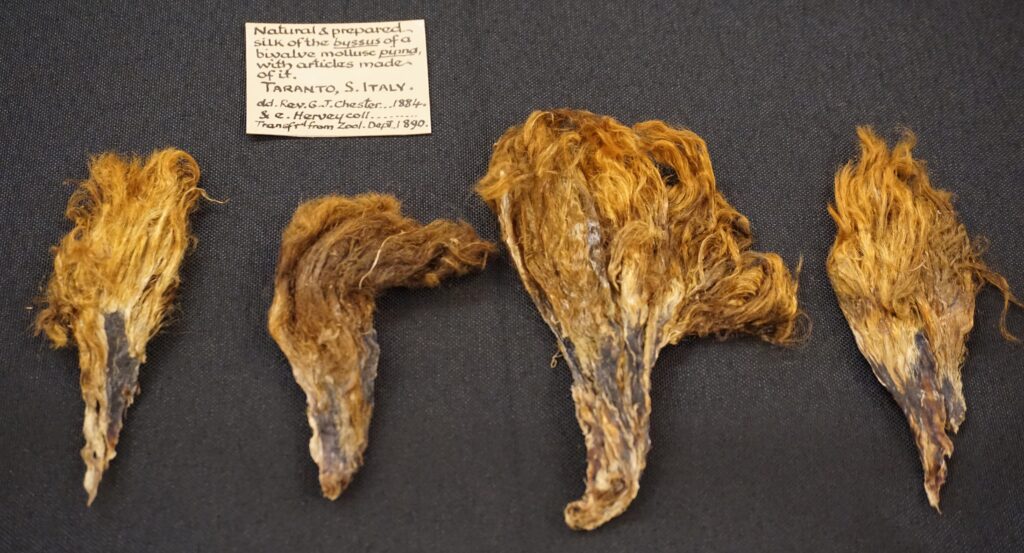The byssal fiber of pen clams can be harvested in many ways, but most of them require the death of the animal. This section contains images and descriptions of live harvest.
Historical References
The historical record speaks of several methods that were used to harvest Pinna nobilis. Because of their size, they are extremely difficult to harvest, but they were historically used as a food source first, with the byssus and mother-of-pearl from their shells used secondarily.

Johann Hieronymus Chemnitz (1730 – 1800) a German naturalist and editor of an extensive conchology cabinet, describes the harvesting of the pen clams as follows: “In many places in the Mediterranean, only in calm and clear weather, when the pen mussels can be seen standing on the sandy bottom, is a stick pushed from above into their always open opening. The pinna immediately closes completely and thereby holds on to the long stick in such a way that it can be turned over, released from its position and thus pulled out.”
Other sources describe harvesting by diving: “The divers then sit on the seabed, dig up the ground surrounding the mussels with their fingers and then try to tear the mussels off with both hands” (Brühl, L., 1938. Mussel silk, In The raw materials of the animal kingdom, eds. F. Pax and W. Arndt Berlin, 963-985).
During the height of sea silk production in the 18th through 20th centuries, fishermen utilized specialized tongs and forks to extract the animals from the seabed while preserving their fibers.
Chiara Vigo of Sant’Antioco, Sardinia, describes diving to the seabed, loosening pen clams from the sea floor, trimming the fibers, and then reburying the animal to preserve its life. It is unclear if this method of harvest does not, in fact, harm the animal. Additionally, many species of pen clams do not have external threads long enough for this approach. Further experimentation must be performed, ideally with animals that are not endangered or threatened.
Harvesting

In my own experience with harvesting Atrina rigida in North Carolina, my team found that harvesting the clams with clamming rakes was ineffective for the preservation of the byssal fibers. While we could extract the clams this way, the fibers, which are fragile, would break away. Therefore, our most effective method of harvest was manually digging the clams out of the seabed and pulling them free from the sand by their fibers. Because Atrina rigida grow to be approximately 10 inches in length, and because they tend to situate themselves in the seabed until only one or two inches of their shells are above the sea floor, this requires digging around the shell to a depth of up to 12 inches in order to reach the fibers. Because of the time required to extract each clam, coupled with the low visibility at the colony site, diving equipment was useful but not necessary.
Because commercial pen clam farming is centered on meat production and not fiber, clams are often harvested without regard for keeping the fibers intact, or the fibers are removed from the animal before being brought to market. However, it is possible to find pen clams in certain markets with their fibers intact. This would be an excellent way to harvest byssus fiber in certain markets were pen clams are commonly sold, such as in Mexico or South Korea. Pen clam fiber can also be collected humanely from beaches where the animals commonly wash to shore during storms, such as in Florida or South Carolina.
Washing/Desalination

The threads are produced by a dedicated organ just underneath the muscle. After opening the shell, I used a razor blade to open this organ and remove the byssus. I have found that using a razor blade to then scrape the portion of the fiber that had existed within that organ is effective in removing any residual matter. This streamlines the washing process and makes it possible to clean the fibers without the use of detergents.
Historical records mention the use of soap in cleaning: “[The fibers are washed] carefully with ordinary water and then with soapy water to remove all the dirt they have picked up in the depths of the sea” (von der Recke, E., 1815. Diary of a journey through a part of Germany and through Italy, in the years 1804 to 1806. Appendix III.: Letter from the Archbishop of Taranto Don Giuseppe Capece-Latro, in response to several inquiries from many European countries, about the nature of the Tarentine pen shell and the method of processing its wool, Berlin: Nicolaische Buchhandlung). Both Arianna Pintus of Sardinia and Joyce Matthys of Florida mentioned using soaps to clean byssus fiber.

I have personally found that the use of soaps and detergents is unnecessary when using the scraping method coupled with a desalination process. Chiaro Vigo mentioned desalination to me when I visited her studio, but she gave no instruction. However, there are many artifact conservation resources that speak on the desalination of artifacts that have been excavated from the ocean, and my methods are based on these.
Proper desalination requires a digital salinity meter, such as those used to test the parts per thousand or parts per million of salt in pools or fish tanks. I was able to purchase one for $30 that was effective enough for my purposes. Once the fiber is scraped free of clam matter, I place it in a bowl with distilled water. The water, which has no salt or mineral content, draws the salt out of the fiber through osmosis. The water is changed twice daily, and I take a reading with the salinity meter before each change. I consider the process complete when the soaking water has tested clean after 24 hours. For the fiber of one animal, this process took four days. For the fiber of ten animals, it took 14 days.


Joyce Matthys wrote to me that she added a small amount of hair conditioner to her rinsing water in order to soften the fibers and make them easier to clean and spin. While I have not personally tried this method, I believe that it could be a useful one on several fronts. First, even after days of soaking – or even washing – the fibers will continue to cling to grains of sand. Also, the fibers tend to create static, which makes the spinning process more difficult. I believe that a wool-safe conditioner could be safe to use on byssus, but I have not yet found a fiber source for such experimentation.
After the fibers have completed their desalination process, the fibers can be laid out on a screen or rack to dry. I did my best to keep the locks intact through desalination and drying, as this greatly improves the cleaning process. Some individuals who collect byssal threads for scientific record, such as those that are found in museums, will tie the locks together at their root ends with string, and this is a helpful practice prior to desalination to keep the locks intact. Once dry, there is no fishy odor whatsoever, and the locks look quite similar to human hair. The byssus is now ready to be cleaned and spun.

